Product Review - Paradigm Reference Series
Speakers - June, 2000
Brian Florian
![]()

|
Paradigm Reference Speakers Studio/40: One 1" Pure Aluminum dome tweeter, One 6.5"Mid/Bass driver, One 6.5" Bass driver. $900 USA Studio/CC: One 1" done tweeter, Two 6.5" Mid/Bass drivers. 8 Ohms nominal. $500 USA. Studio/ADP: Two 1" dome tweeters, Two 6.5"" Mid/Bass drivers with. 53 Hz - 20 kHz, 8 Ohms nominal. $900 pair USA. PW-2200: 250Watt Powered Subwoofer. One 12" Driver. $800 USA |
| Paradigm Electronics, 101 Hanlan Road, Woodridge, Ontario, CANADA L4L 3P5; Phone 905-850-2889; Fax 905-850-2960; E-Mail [email protected]; Web http://www.paradigm.ca/ |
Introduction
As I peruse our back-issues it is obvious that we have done more reviews of loudspeakers than any other product, by a margin. The reasons in my mind are simple: (a) There is simply an overabundance of choice out there. This abundance of choice is economically made possible by (b) home theater's growth and (c) the fact that arguably, more so than any other piece, the loudspeakers have the greatest influence on a system's overall ‘character’. Thus they are subject to upgrades and swaps as an individual's taste changes. Like decent wine, no one is satisfied with sampling just one label. Despite every manufacturer’s claim of sonic truth, irrespective of price point I might add, all speakers impart their own slant on sound. This is not a bad thing, just a simple fact. No matter how much a pair of speakers cost, there is still no one perfect design. If there were, we’d all have a pair and be done with it. So what is a speaker maker to do in this veritable sea of audio transducers? As we strolled the aisles of CES-2000, lined with innumerable speaker makes and models, our editor and I remarked to each other, "It must be tough to compete in that part of the business".
Paradigm continues to be very much up to the task. Their strategy: Offer speakers whose performance equals others, but at a lower price that almost confusingly puts them in a different category. Case in point: The Reference Series, introduced by Paradigm in 1998, and said by them to be the "cost no object" ultimate speaker line. But they range in price from only $800 - $2,400cnd a pair?!? Most would consider a "cost no object" speaker to hit 5 figures. Yet, if the price/performance ratio of Paradigm’s past products is any indication, these could genuinely be a steal in the world of high-definition loudspeakers. From the Reference’s first release, I have heard them informally on many occasions and very quickly ear marked them as a candidate for my next affordable reference speaker (no pun intended). Last fall, the whole Reference line was retooled with the company claiming their engineers "found ways to make them better". Clearly it was time Secrets had a serious listen.
A handful of e-mails, a conversation with Mark Aling at CES, and a few months of patience yielded a review set consisting of:
- One pair Studio/40 stand mounted monitors for 2 channel music and mains in multi-channel.
- One Studio/CC, a purpose built, dedicated center channel speaker.
- One pair Studio/ADP, dedicated dipolar surround speakers.
To complete the Home Theater setup for our tests, Paradigm also included a PW-2200 Power Subwoofer.
Suggested list of the ensemble, US$3,100.
Studio/40
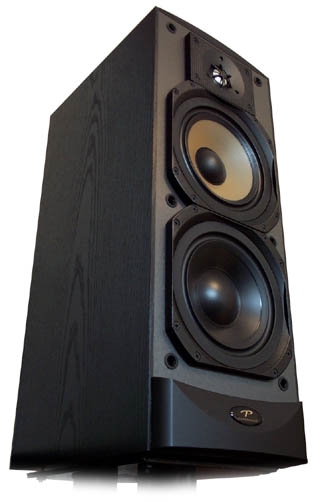 If there is one thing true about speakers,
it's that no
two models sound exactly alike, even if their overall designs are the same. But even visually, the
40s are a delicate break from the ordinary: slender monoliths, not tall enough to
stand on the floor, yet perched on abnormally short stands. A 1" aluminum dome
tweeter crosses over at 1,500 Hz to a 6.5" mid/bass driver, which is then supplemented
by a second 6.5" driver to help from 400 Hz on down. Add two ports on the back,
bi-wire/bi-amp all metal binding posts and voila, a 2 � way speaker that can only be
described as something halfway between a bookshelf and a floor stander (a bookshelf-and-a-half?).
But a slick design alone does not a good speaker make. I don’t want to regurgitate
Paradigm’s literature, but the complement of technology at work simply has to be
touched on.
If there is one thing true about speakers,
it's that no
two models sound exactly alike, even if their overall designs are the same. But even visually, the
40s are a delicate break from the ordinary: slender monoliths, not tall enough to
stand on the floor, yet perched on abnormally short stands. A 1" aluminum dome
tweeter crosses over at 1,500 Hz to a 6.5" mid/bass driver, which is then supplemented
by a second 6.5" driver to help from 400 Hz on down. Add two ports on the back,
bi-wire/bi-amp all metal binding posts and voila, a 2 � way speaker that can only be
described as something halfway between a bookshelf and a floor stander (a bookshelf-and-a-half?).
But a slick design alone does not a good speaker make. I don’t want to regurgitate
Paradigm’s literature, but the complement of technology at work simply has to be
touched on.
The tweeter, consistent through the entire Reference line, is a 1" aluminum dome on a cloth suspension. "Cripes, not another bright metal dome" you’re thinking. Admittedly, I did too, at first. Listening would prove me wrong. Paradigm uses a second magnet behind the first one to increase magnetic energy and terminates the design with a mineral filed damping chamber. The assembly is fastened to a thick (10 mm) cast aluminum faceplate/chassis that also acts as a heat sink, a very mild horn, and phase plug.
All the Reference models (with the exception of the surrounds) allow for bi-wiring or bi-amping (meaning two sets of binding posts with removable jumpers connecting them together). The crossovers for the high and low sections are on their own boards, fastened on the inside to the binding posts. I am in no position to visually judge cross-over components but I can tell you the internal wires running to the drivers is of heavier gauge than most, and I’m told it is a very high purity copper.
The bass drivers naturally start with a cast chassis made of aluminum which incorporate heat sink ‘fins’ for heat dissipation. The magnets are huge, the voice coil is vented, and the suspension is of synthetic butyl (rubber). The mid/bass driver cone is fairly unique, being made of mica-loaded polymer, while the bass driver is a more conventional polypropylene.
Finally, an internal brace system makes for a very rigid and inert box, confirmed by a rap with the knuckle: Dead as a tomb.
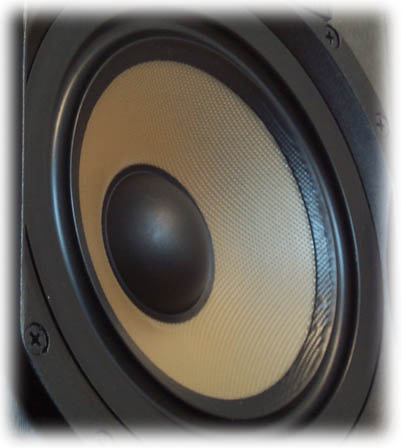 I have to mention all of this high-end "stuff" because I find it a
treat in a speaker that streets for under $1Kcnd a pair. But most all good speakers claim
"the finest" components. The proof is in the proverbial pudding.
I have to mention all of this high-end "stuff" because I find it a
treat in a speaker that streets for under $1Kcnd a pair. But most all good speakers claim
"the finest" components. The proof is in the proverbial pudding.
Although at first hard to believe, the 40s do in fact impart as much detail as speakers I’ve heard costing appreciably more. For some consumers, this means that things like spit, air buffeting on a microphone, or the distant cough on a live recording will be easier to pickup on. In a more useful context, every rick-tick-a-tick of a high-hat cymbal is its own unique hit, not a monotony. Each pluck of a guitar sting, a sonic event. Earlier this year my older brother introduced me to recordings of Andrea Bocelli. "Listen to that snare in the background" he'd say. At that time, the drum he was looking for was quite frankly hard to pick out, buried somewhere in the mix. When I heard the same piece with the Reference set, the lone snare could be picked out with ease.
The treble strikes me as neither forward nor laid back, and thus I have to say, neutral. Metal domes have gotten a somewhat deserved reputation for brightness, sometimes harshness, which exasperates any sibilance in the system. This is something I’m particularly sensitive to and found the Studio/40s to be more responsible transducers in this regard. Put simpler, their top end is comfortable and clean. This is not to say that they will mask aberrations generated by the system or the recording. Point is they add none of their own mud to the mix. More than once I spent an entire weekend continually listening to music and never fell into that phase where I just needed to turn it off for a while.
The midrange follows the neutral theme. Female singers sound healthy (as in no sound of chain-smoking chestiness). Credible (or I might say, believable) choral and clean deep male vocals. The bench mark Ladysmith Black Mambazo delivered without any distractions: not too heavy but still maintaining the weight of a deep male vocal. The complex guitars of Dire Straits were an absolute delight to experience.
Imaging, as can be expected, is exemplary. The soundstage is successfully resolved and defined in three dimensions, giving you not only the left to right, but the difficult front to back.
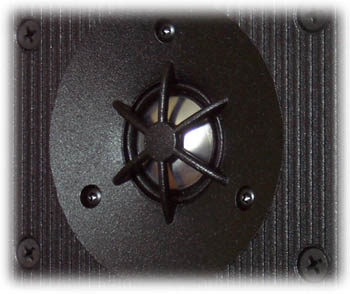 I’ve always had a preference for small stand-mounted
speakers. Not that I haven’t heard some really great floor-standers but there is just
something about a small box. The lack of a large front baffle makes it so easy for them to
do justice to the critical midrange to which our hearing is most sensitive. But what of
bass, and to a lesser extent, dynamics? Sure we've all witnessed some wild excursion from
high-end small drivers, but there is only so much a 6.5" cone can do. A slightly
larger box and a doubling of the surface area participating in the bass, and Paradigm has
come up with a speaker that embodies the virtues of small monitors with bass and dynamics
favorably comparing to much larger enclosures. While this last statement
does not describe an industry first, remember the affordable price at which these speakers are
achieving their good sound. For placement, they are not to fussy in terms of
imaging performance, but to get the best bass and smoothest treble will take a little
positional tweaking. Done right, you can expect a well resolved bass to around
40 Hz and
still useful output in the 30s. And it's that nice tight bass without any buzz. In
any 5.1 situation, you will be adding a subwoofer and can comfortably crossover the 40s
quite low (45 Hz - 50 Hz would be good). In playing them them loud, I witnessed a virtually sky
scraping headroom, able to keep pace at the high SPLs. If you like your movies
loud, a high-pass is recommended to eliminate any sacrifice to their good qualities.
I’ve always had a preference for small stand-mounted
speakers. Not that I haven’t heard some really great floor-standers but there is just
something about a small box. The lack of a large front baffle makes it so easy for them to
do justice to the critical midrange to which our hearing is most sensitive. But what of
bass, and to a lesser extent, dynamics? Sure we've all witnessed some wild excursion from
high-end small drivers, but there is only so much a 6.5" cone can do. A slightly
larger box and a doubling of the surface area participating in the bass, and Paradigm has
come up with a speaker that embodies the virtues of small monitors with bass and dynamics
favorably comparing to much larger enclosures. While this last statement
does not describe an industry first, remember the affordable price at which these speakers are
achieving their good sound. For placement, they are not to fussy in terms of
imaging performance, but to get the best bass and smoothest treble will take a little
positional tweaking. Done right, you can expect a well resolved bass to around
40 Hz and
still useful output in the 30s. And it's that nice tight bass without any buzz. In
any 5.1 situation, you will be adding a subwoofer and can comfortably crossover the 40s
quite low (45 Hz - 50 Hz would be good). In playing them them loud, I witnessed a virtually sky
scraping headroom, able to keep pace at the high SPLs. If you like your movies
loud, a high-pass is recommended to eliminate any sacrifice to their good qualities.
Cosmetically, there is something for everyone, as the choice of finishes are many: light cherry and dark rosenut laminates are available in addition to the requisite black. For a nominal increase in price, all three shades can be a real wood veneer on the sides.
Studio/CC
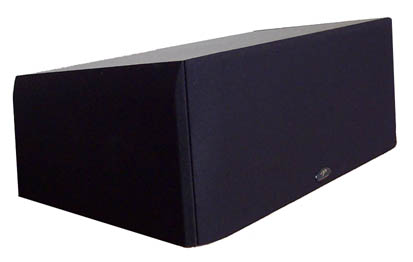 The Reference center uses the exact same tweeter and
mid/bass driver as the 40s, only in a horizontal d’Apolito array. It’s cabinet
is visually unique, a design that is becoming a Paradigm signature: The side profile is
something of an uneven trapezoid which ends up giving the front baffle a slight upward
angle. The endcaps are false grilles being of the same cloth as the real grille on the
front. This gives it a pleasant sculpted look and makes it trap light, an important trait
for an object so close to a high performance visual system in a darkened room.
The Reference center uses the exact same tweeter and
mid/bass driver as the 40s, only in a horizontal d’Apolito array. It’s cabinet
is visually unique, a design that is becoming a Paradigm signature: The side profile is
something of an uneven trapezoid which ends up giving the front baffle a slight upward
angle. The endcaps are false grilles being of the same cloth as the real grille on the
front. This gives it a pleasant sculpted look and makes it trap light, an important trait
for an object so close to a high performance visual system in a darkened room.
It should almost go without saying that the Studio/CC is an excellent match for the Studio/40s with an almost identical driver complement and power handling. But the design curtails the bass extension notably sooner than the Studio/40, in my room around 55 Hz. This is not to say that it won't handle a full range signal, it simply won't usefully voice the bottom octave. I can think of no situation in which a system based on the Studio/CC would not cross it over to a subwoofer or at least mains of substantial mettle.
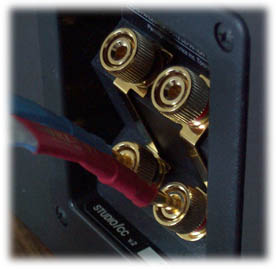 My listening sessions and (almost daily) movie viewing
prove the Studio/CC to have much the same characteristics as the 40s. Easy highs, oh so
neutral midrange, and controlled low end. The CC is one of only a few centers that
have achieved what I call 'the startle' factor. This is where the TV is on but I'm
not paying attention. I suddenly get startled because the dialogue in a sit-com is
so believable, my mind tells me there is an uninvited guest in the house. The last
center that did that was twice the price of the CC. But like the 40s, the CC
is revealing . . . to a fault. I’ve said before, movie soundtrack dialogue is seldom
perfect, often imparting an edgy quality, with the pop and crackle of microphone
preamp
clipping (among other plights). In its effort to render truth, the CC will impart
every nuance of the soundtrack, including blemishes. This make all three front speakers a
good set for evaluating changes in the rest of a system. Subtle swaps, such as changing a
cable, are easier to identify with these speakers. When going from stock 12 gauge wire to
the Nordost Blue Heaven, for example, the capacitance of the former was embarrassingly apparent.
My listening sessions and (almost daily) movie viewing
prove the Studio/CC to have much the same characteristics as the 40s. Easy highs, oh so
neutral midrange, and controlled low end. The CC is one of only a few centers that
have achieved what I call 'the startle' factor. This is where the TV is on but I'm
not paying attention. I suddenly get startled because the dialogue in a sit-com is
so believable, my mind tells me there is an uninvited guest in the house. The last
center that did that was twice the price of the CC. But like the 40s, the CC
is revealing . . . to a fault. I’ve said before, movie soundtrack dialogue is seldom
perfect, often imparting an edgy quality, with the pop and crackle of microphone
preamp
clipping (among other plights). In its effort to render truth, the CC will impart
every nuance of the soundtrack, including blemishes. This make all three front speakers a
good set for evaluating changes in the rest of a system. Subtle swaps, such as changing a
cable, are easier to identify with these speakers. When going from stock 12 gauge wire to
the Nordost Blue Heaven, for example, the capacitance of the former was embarrassingly apparent.
Dialogue, music, explosions, ray guns: All no problem for the Studio/CC. As the volume rises to the so called reference playback level (again, no pun intended), you can still make out the small things. The club scene in the early portion of "The Matrix" is a hard one to do at loud levels. There is techno-rock blaring, and Trinity is darn near whispering to Neo. This intelligibility of this dialogue is lost on lesser centers, but the CC delivers every word regardless of output level.
Studio/ADP
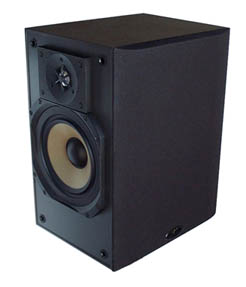 While making the arrangements for this review at CES, I proposed to Mark
Aling of Paradigm a review of the either the 20’s or 40s, and the CC. With a
father-like pat on an ‘ADP’ speaker, Mark interjected " . . .
and a pair of
these for the surrounds". "Sure, yeah," I replied. I don’t think I
could have been more indifferent. As it turns out, Mark would have the last
grin: I
absolutely love these surrounds!
While making the arrangements for this review at CES, I proposed to Mark
Aling of Paradigm a review of the either the 20’s or 40s, and the CC. With a
father-like pat on an ‘ADP’ speaker, Mark interjected " . . .
and a pair of
these for the surrounds". "Sure, yeah," I replied. I don’t think I
could have been more indifferent. As it turns out, Mark would have the last
grin: I
absolutely love these surrounds!
Take the same tweeter and midbass from the other models, one set on the front and the other on the back, put the connections on one side and a false grille (like on the CC) on the other, and you’ve got a Studio/ADP. The acronym stands for Adapted Di-Polar: The relative phase of the front and back is unique. At the top end they are dipolar, at the bottom bipolar. In this way, Paradigm gets the spaciousness of a dipole without the bass cancellation.
I’ve always believed in dipolar surrounds because I believe in matching the system to the signature of the place for which the soundtrack is mixed. Yes, direct radiators work and can provide better imaging with discrete channel soundtracks, but this is not the system that the motion picture sound engineers have in mind. With the exception of the emerging multi-channel music, a motion picture soundtrack is mixed to sound ‘correct’ over a cinema’s surround speaker array. So even though a certain sound effect would sound great from a rear direct radiator, it will be tailored to sound correct when played over 12 speakers.
Approximating the signature of 8 - 12 speakers on each side is what dipoles are all about. The discrete surrounds of Dolby Digital and DTS are no exception, and are in no way poorly reproduced by a pair of di’s.
 The
timbre match of the Studio/ADP to the front three
models is uncanny, especially since the drivers are firing at 900 to the ear. When a
sound is in both rears (‘center surround image’), it is genuinely omnipresent.
Rain falls everywhere. If the sound is to the side, it is ‘somewhere’ to that
side. And when that plane comes in from behind, it hands over from rear to front with a
silky smooth transition. As a person who attends the cinema frequently (encompassing a
variety of cinema sizes, and sound systems), I can tell you the ADPs in concert with other
Reference models, simulate the signature of the cinema surrounds, and do so with
impressive fidelity and resolution. The only reservation is that the shape, dimensions,
and layout of some rooms just don’t ‘work’ for dipoles. Talk to your
Paradigm dealer.
The
timbre match of the Studio/ADP to the front three
models is uncanny, especially since the drivers are firing at 900 to the ear. When a
sound is in both rears (‘center surround image’), it is genuinely omnipresent.
Rain falls everywhere. If the sound is to the side, it is ‘somewhere’ to that
side. And when that plane comes in from behind, it hands over from rear to front with a
silky smooth transition. As a person who attends the cinema frequently (encompassing a
variety of cinema sizes, and sound systems), I can tell you the ADPs in concert with other
Reference models, simulate the signature of the cinema surrounds, and do so with
impressive fidelity and resolution. The only reservation is that the shape, dimensions,
and layout of some rooms just don’t ‘work’ for dipoles. Talk to your
Paradigm dealer.
The ADP pair includes hardware to mount them flush with a dry-wall surface. As such, I’d prefer to see the binding posts a little further recessed into the speaker to allow space for more elaborate cable terminations. There is barely enough room for my Nordost Z-plugs.
PW-2200
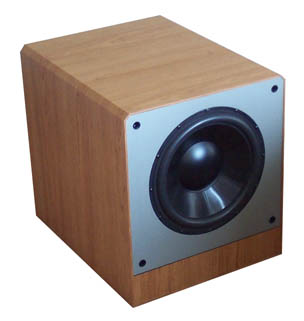 While not technically of the Reference family, the PW-2200
powered subwoofer is a suitable match for this ensemble, both in performance and price. It
features an amplifier quoted as delivering 250 watts rms to a 12" polypropylene cone
with rubber surround. As we expect from Paradigm, the driver’s frame is cast metal
with heat sink fins. The design is a classic vented enclosure with an enormous port on the
rear. Beside the port is an I/O panel as complete as any subwoofer could want. Input and
output is provided for both line and speaker level connections, and all outputs receive a
fixed, passive 60 Hz high-pass (12 dB/octave for the line-level, 6 dB/octave for the
speaker-level). The requisite volume knob is augmented by continuously variable low-pass
(40 Hz -120 Hz) and phase (00 -1800) adjustments.
While not technically of the Reference family, the PW-2200
powered subwoofer is a suitable match for this ensemble, both in performance and price. It
features an amplifier quoted as delivering 250 watts rms to a 12" polypropylene cone
with rubber surround. As we expect from Paradigm, the driver’s frame is cast metal
with heat sink fins. The design is a classic vented enclosure with an enormous port on the
rear. Beside the port is an I/O panel as complete as any subwoofer could want. Input and
output is provided for both line and speaker level connections, and all outputs receive a
fixed, passive 60 Hz high-pass (12 dB/octave for the line-level, 6 dB/octave for the
speaker-level). The requisite volume knob is augmented by continuously variable low-pass
(40 Hz -120 Hz) and phase (00 -1800) adjustments.
The goal of any subwoofer is academically a simple one: Play Low, Play Loud, Play Clean. Actually doing this is in practice decidedly difficult when things like cost and size are factors. It seems that again Paradigm has managed to bend the financial rules, delivering a subwoofer that sounds more expensive than it is.
 Right from day one I could feel this gem reaching down
several Hz lower than my benchmark affordable sub, and it does so with a driver 3"
smaller in diameter. As with any sub, placement is critical to performance. Done right, I
was able to get useful output to the low 20s and still audible bass at 20 Hz. And
loud? Boy can it! But no one, not even Paradigm, can bend the rules of
physics. At the highest output, the 12" cone loses some control, and the sound begins
to feel latent or loose. This is only at the highest output, and is thus minor,
but as a
conscientious journalist, I must note it. At this price, you might even go for two units and
halve each one's workload. Hard pressed will you be to find better subwoofer
performance at this price.
Right from day one I could feel this gem reaching down
several Hz lower than my benchmark affordable sub, and it does so with a driver 3"
smaller in diameter. As with any sub, placement is critical to performance. Done right, I
was able to get useful output to the low 20s and still audible bass at 20 Hz. And
loud? Boy can it! But no one, not even Paradigm, can bend the rules of
physics. At the highest output, the 12" cone loses some control, and the sound begins
to feel latent or loose. This is only at the highest output, and is thus minor,
but as a
conscientious journalist, I must note it. At this price, you might even go for two units and
halve each one's workload. Hard pressed will you be to find better subwoofer
performance at this price.
The usual black vinyl is supplemented by options of light cherry (our review unit) and dark rosewood vinyl.
Further notes
All speakers in this set are quoted by Paradigm as being ‘compatible with 8 Ohms’ and my Yamaha receiver had no problem driving them within its limits. But it should be said that these speakers make the best of whatever comes before them. As the input equipment gets better, so do these speakers. When coupled with my THX spec power amplifier, the loudspeakers voiced more controlled and dynamic sound.
Conclusion
It has always been our amusement at Secrets to be rarely, if ever, quoted by manufacturers. We seldom use the sort of hyperbole and rave that make good advertising copy, valuing instead the plain and simple talk. Yet here at the end of this, what has become a lengthy review, I find myself wanting to rave just a little. I can tell you that these speakers are what Paradigm wants you to know that they are: An incredible value. I don’t make a lot of money, and for what means I do have, the competition is fierce: gas, mortgage, food, and so on. Anything anyone can do to bring high-performance within my reach deserves special recognition, and the Reference speakers do just that. It scares me to think that the flagship of the series, the three way, four driver Studio/100 monoliths, are just under $2,400cnd a pair. In speakers, like cars, everyone has their favorite. I can’t tell you what is right for you, but if the Reference models are in your price range, I urge you to put them on your list of models to audition.
Related Hardware:
Yamaha RX-V795a Processor/Receiver
Rotel RB-985 5 channel THX amplifier
Toshiba 2108 DVD player
Yamaha CDC-695 CD player
Nordost Blue Heaven, Moonglow, and S-Optix cable
Sony KV-27S36 Trinitron TV
Notable:
As in the past, our review set from Paradigm arrived with a pair of Premier brand speaker stands, this time from the J series. At 20" tall, they are shorter than most and thus perfect for the Studio/40s profile. Even without filling them with sand, these stands are heavy! I went ahead and filled the review set with cat litter (new, not used) to dampen any ringing or resonance, making them not only unusually solid but also silent. The spiked feet which are found on most all stands, including the J series, are there to decouple the speaker from the floor. Premier has gone one step further, providing small adjustable spikes on the top plate to decouple the speaker from the stand itself! (This makes four tiny holes on the bottom of your speaker, so isolation pads are also provided as an option.) With a street price of around $250cnd, these are definitely worth checking out.
- Brian Florian -
![]()
� Copyright 2000 Secrets of Home Theater & High Fidelity
Return to Table of Contents for this Issue.


